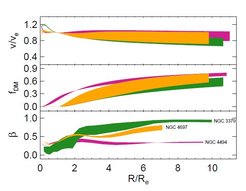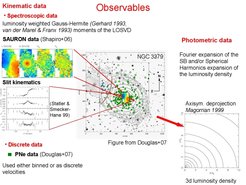
Range of valid models for NGC 4697 (yellow), NGC 3379 (green) and NGC 4494 (magenta). From top to bottom as a function of radius: circular velocity, dark matter fraction, and anisotropy parameter.

Typical set of observables as used to construct NMAGIC dynamical models of NGC 3379. The kinematic observations consist of integral field SAURON kinematic data (Shapiro et al. 2006) extending to ∼ 1/2-1 Re, slit kinematic data (Statler & Smecker-Hane 1999) out to ∼ 1 1/2 Re and planetary nebulae (PNe) data (Douglas et al. 2007) out to ∼7 Re, which allow to probe the outer halo. The luminosity distribution of the dynamical model is constrained from surface brightness photometric data (Capaccioli et al. 1990, Gebhardt et al. 2000). Often the surface brightness (SB) data are deprojected under some symmetry assumptions to obtain a luminosity density. For deprojecting the SB profile, we use Magorrian's (1999) deprojection method to obtain an axisymmetric intrinsic luminosity distribution.

